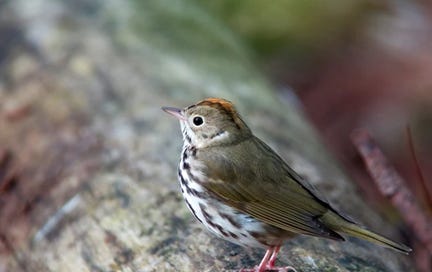Five Parks, Fifty-Seven Birds: 5 Weeks of Birding Bliss in Durham Parks
On Friday, May 23, the Outdoor Recreation unit wrapped up their 5-part birdwatching series that began in April. A member from the Outdoor Recreation staff and a member from New Hope Bird Alliance co-led these birdwatch outings. The purpose of this program was to highlight a few city parks while also demonstrate that birds are everywhere and anyone can be a birder! The Outdoor Recreation unit wants to give a massive thank you to New Hope Bird Alliance for partnering with them for this series!
The birdwatch series started off at Twin Lakes Park on April 25, a park known mostly for great fishing and a soccer pitch. However, it should also be known as a birding hotspot! The “spotlight” bird of this outing was definitely the Ovenbird, an elusive warbler that builds its nest on the ground in leaf litter and teases birdwatchers with its loud song but never seems to want to show itself. We were able to draw out the ovenbird from the leaves of the forest floor and get it to fly right over us. We got a great look at it perched up on a tree branch just above eye level!
The next spot was Indian Trail Park on May 2. This park is located between the Hillandale Golf Course and the West Ellerbe Creek Trail. This outing was a massive success with multiple “spotlight” birds! Within ten minutes of the birdwatch outing, we spotted a Rose-breasted Grosbeak sitting high up in the tree canopy. The male Rose-breasted grosbeak looks like he has a bleeding-heart right on his chest! These birds are currently migrating through North Carolina and sometimes can be seen at birdfeeders with black sunflower seeds. Alongside the Rose-breasted Grosbeak, participants were also gifted with seeing other beautiful birds such as the Black-throated Blue Warbler, a Swainson’s Thrush, a Scarlet Tanager, and a Black-and-white Warbler.
The next stop of the birdwatch series was at a place known to be a bird hotspot, Sandy Creek Park. One would think that since this park is located so close to 15-501, it wouldn’t be an ideal spot for birds. However, the marshy area filled with dead trees, running water, tree coverage, and a plethora of food makes it a bird heaven! The bird that stole the show at Sandy Creek was the Yellow-crowned Night Heron. This bird that can be easily mistaken as a Great Blue Heron to the untrained eye. Yellow-crowned Night Herons love to stalk the banks of Sandy Creek’s ponds in search of crayfish. The best thing about these birds is that they are easy to spot and big enough to be seen without binoculars! They are bold in appearance as well as attitude, and they did not fly away when we got fairly close to them.
The birdwatch series continued on with visiting Spruce Pine Lodge on May 16. This Durham city park is technically located in Bahama is a great place for camping, as well as birdwatching. Participants got a quick look at the brightly colored Hooded warbler as it flew across an open space and disappeared into the underbrush. Alternatively, participants got to spend some quality time with a Summer Tanager, a bird that is apart of the Cardinal family. Male Summer Tanagers have brilliant red plumage while the females have yellowish plumage. A cool fact about Summer Tanagers is that they love eating bees and wasps, but before they do, the tanager first rubs the insect on the tree branch to remove the stinger. Birds are so cool!
The last spot of the birdwatch series was at the beloved park, West Point on the Eno. Near the McCown Mangum House, birds are abundant! Flying from the picnic area to the Crepe myrtle trees to the photo museum building, the participants’ heads were on a constant swivel. A Red-eyed Vireo kept a close eye on us from a tree branch slightly hidden behind the foliage while an Eastern Wood-Pewee posed bravely out in the open. As we strolled along, a Northern Parula sang loudly, stopping us in our tracks. These birds are often heard with their distinct, rising trill but not often seen. We were lucky enough to get a great look at this yellow and blue-colored warbler. Northern Parulas are known to stick to the tree canopy, so it was truly a gift that this particular one came down to say hi to the group!
In total, we saw and heard 57 species! The bird that graced us with its presence the most was North Carolina’s state bird, the Northern Cardinal. See below a total list of all the birds we encountered over the course of this 5-part birdwatching series!
Total Bird List:
Acadian Flycatcher – 4
American Crow – 11
American Goldfinch – 4
American Robin – 6
Barn Swallow – 2
Black-and-white Warbler – 1
Black Vulture – 4
Blue-gray Gnatcatcher – 19
Brown-headed Cowbird – 5
Brown-headed Nuthatch – 5
Canada Goose – 18
Carolina Chickadee – 17
Carolina Wren – 13
Cedar Waxwing – 1
Chimney Swift – 7
Chipping Sparrow – 6
Common Grackle – 11
Common Yellowthroat – 4
Downy Woodpecker – 10
Eastern Bluebird – 10
Eastern Kingbird – 1
Eastern Phoebe – 4
Eastern Towhee – 4
Eastern Wood-Pewee – 4
Fish Crow – 1
Gray Catbird – 4
Great Blue Heron – 4
Great-crested Flycatcher – 5
Hooded Warbler – 3
House Finch – 2
Killdeer – 1
Mourning Dove – 2
Northern Cardinals – 61
Northern Mockingbird – 1
Northern Parula – 10
Northern Rough-winged Swallow – 3
Ovenbird – 7
Pileated Woodpecker – 1
Pine Warbler – 6
Red-bellied Woodpecker – 15
Red-eyed Vireo – 15
Red-shouldered Hawk – 2
Red-winged Blackbird – 3
Rose-breasted Grosbeak – 3
Ruby-throated Hummingbird – 2
Scarlet Tanager – 2
Summer Tanager – 3
Swainson’s Thrush – 1
Tree Swallow – 5
Tufted Titmouse – 19
Turkey Vulture – 1
White-eyed Vireo – 4
White-throated Sparrow – 3
Yellow-crowned Night Heron – 4
Yellow-rumped Warbler – 1
Yellow-throated Warbler - 3








